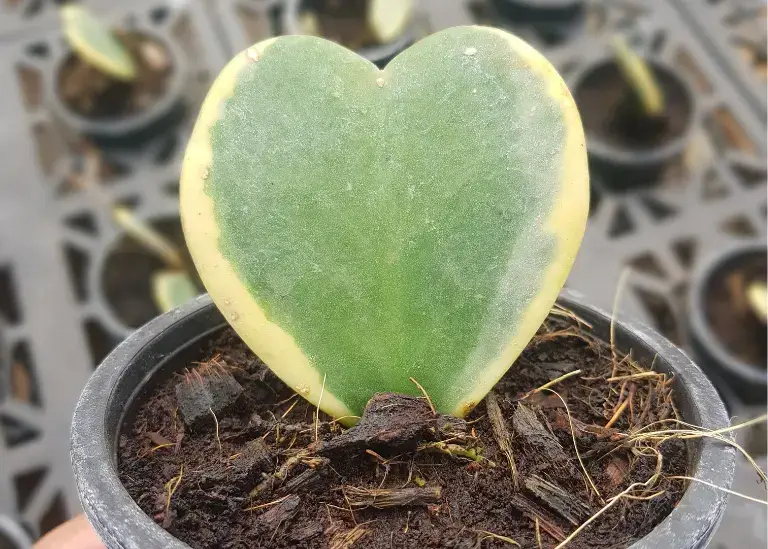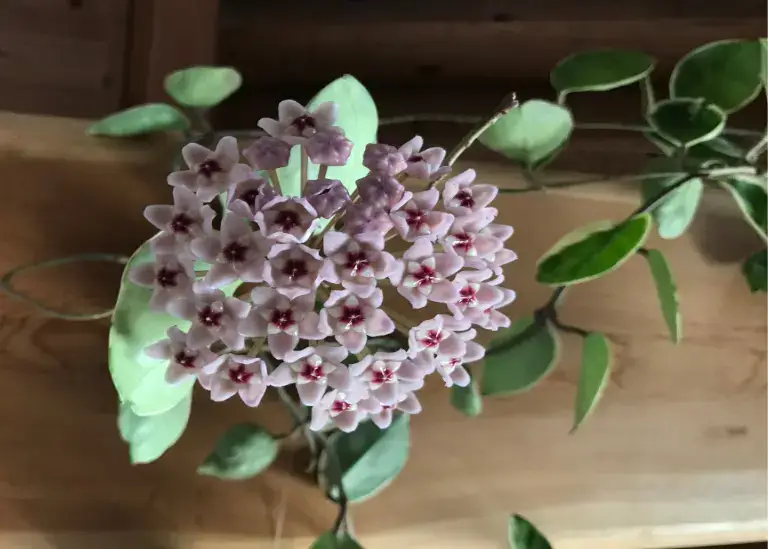Hoya Plant Care: Complete Wax Plant Care Guide & Tips

Discovering the enchanting world of hoya plants opens endless possibilities for plant enthusiasts seeking low-maintenance yet stunning houseplant additions.
These remarkable tropical specimens, known as “wax plants” or porcelain flowers, captivate gardeners with their waxy leaves and fragrant star-shaped flowers.
Whether you’re caring for your first hoya or expanding your collection, this comprehensive hoya plant care guide provides everything you need to successfully grow hoya plants and enjoy their spectacular blooms for years to come.
What Is a Hoya Plant? (Wax Plant Overview)
Hoya plants are tropical climbing vines native to Southeast Asia and Australia, where they naturally grow as epiphytes on trees and rocks. These distinctive plants are called wax plants due to their thick, glossy waxy leaves that feel almost artificial to the touch. The hoya species encompasses over 200 varieties, from the popular hoya carnosa to specialty types like hoya curtisii and hoya compacta.
What makes hoyas truly special as indoor plants is their ability to produce clusters of star-shaped flowers that emit an intoxicating fragrance, particularly in the evening. These hoya flowers often appear waxy and porcelain-like, explaining why they’re sometimes called “porcelain flowers.” With proper care, a single hoya plant can live for decades, making them excellent long-term houseplant investments.
The most common hoya varieties include:
- Hoya carnosa – The timeless variety with sturdy, oval-shaped foliage
- Hoya compacta – Features curled, rope-like foliage
- Hoya curtisii – A trailing type with tiny, patterned foliage
- Green hoya varieties perfect for beginners
Hoya Plant Care Guide – An Overview

Learning how to care for a hoya plant is surprisingly straightforward, making them excellent choices for both novice and experienced plant parents. These easy care houseplant specimens are remarkably forgiving and adapt well to various indoor conditions when provided with basic requirements.
Quick Hoya Care Summary:
- Light: Bright indirect light (no direct sun)
- Water: When soil is dry (typically weekly in summer)
- Humidity: 50-60% preferred but adapts to average home humidity
- Temperature: 65-80°F (18-27°C)
- Soil: Well-draining, chunky potting mix
- Fertilizer: Monthly during spring and summer growing season
- Difficulty Level: Easy to care for with proper understanding
The key to successful hoya care lies in mimicking their natural epiphytic environment—providing excellent drainage, adequate humidity, and allowing the plant to dry between waterings.
Essential Hoya Care Tips
Light Requirements for Hoya Plants
Proper lighting is crucial when you care for a hoya plant. These plants thrive in bright indirect light but can suffer damage from direct sunlight. Place your hoya near an east or west-facing window where it receives gentle morning or evening light without harsh afternoon rays.
Optimal Light Conditions:
- 4-6 hours of bright light daily
- Filtered sunlight through sheer curtains
- Supplement with a grow light if natural light is insufficient
- Avoid moving your plant frequently once established
When the plant isn’t receiving adequate light, you’ll notice slower growth and reduced flowering. However, too much direct sun can scorch the waxy leaves and cause permanent damage. When shifting your hoya into stronger light, ease it in slowly to help it adjust.
Water Requirements: How Often Should I Water My Hoya?
Understanding when and how to water your hoya is essential for healthy growth. These plants store water in their thick leaves, making them relatively drought-tolerant. The golden rule care for hoya is to water when the soil is dry, typically every 7-10 days during active growing periods.
Proper Watering Technique:
- Check soil moisture 1-2 inches deep before watering
- Water thoroughly until excess drains from the bottom
- Allow soil to dry completely between waterings
- Reduce frequency during winter months when growth slows
To water your plant effectively, give your hoya a deep drink rather than frequent light waterings. This encourages healthy root development and prevents the common mistake of overwatering. Remember, it’s better to underwater than overwater—hoyas are much more tolerant of drought than soggy soil.
Seasonal Watering Schedule:
- Spring and Summer: Water weekly when soil feels dry
- Winter Months: Reduce to every 2-3 weeks as growth slows
Humidity Needs for Growing Hoya Plants Indoors
While hoyas adapt to average household humidity, they truly thrive with increased moisture in the air. Aim for 50-60% humidity to encourage optimal growth and flowering, though most hoya species tolerate lower levels without significant stress.
Increasing Humidity for Your Hoya:
- Group plants together to create a microclimate
- Set your pot on a tray of damp pebbles to gently raise humidity around the plant.
- Employ a humidifier during dry seasons
- Avoid misting directly on leaves (can cause fungal issues)
Higher humidity levels often correlate with better hoya blooms and overall plant health. During winter months when indoor air becomes particularly dry, consider increasing humidity around your plant to maintain consistent growing conditions.
Best Soil for Hoya Plant
Hoyas need excellent drainage to prevent root rot, their most common cause of decline. Create a chunky, well-aerated potting mix that mimics their natural epiphytic growing environment.
Recommended Soil Mix Recipe:
- 40% quality potting soil
- 30% orchid bark or coconut husk
- 20% perlite for drainage
- 10% sphagnum moss for moisture retention
This combination ensures proper drainage while retaining enough moisture and nutrients for healthy growth. Avoid heavy, moisture-retentive soils that can suffocate roots and lead to plant failure.
Temperature Requirements for Indoor Hoya Care
As tropical plants, hoyas prefer warm, stable temperatures similar to their native habitat. Maintain temperatures between 65-80°F (18-27°C) for optimal growth, avoiding sudden fluctuations that can stress the plant.
Temperature Considerations:
- Protect from cold drafts and heating vents
- Avoid placing near frequently opened doors
- Maintain consistent temperatures year-round
- During heat waves or cold snaps, pull your hoya back from drafty or sunny windows to keep it safe
How to Get Hoyas to Bloom

The million-dollar question every hoya owner asks: “Why is my hoya not flowering?” Getting hoya blooms requires patience, proper care, and understanding of their blooming requirements. Most hoyas won’t flower until they’re mature (2-3 years old) and have established a strong root system.
Requirements for Hoya Flowers:
- Adequate bright light exposure
- Consistent care routine with proper watering cycles
- Slight root binding (don’t repot too frequently)
- Stable environmental conditions
- Patience—some varieties take years to bloom
Once your hoya produces flowers, avoid moving your plant or disturbing the flower spurs, as these will produce new flowers year after year. The fragrant hoya blooms are worth the wait, often lasting several weeks and filling your home with their sweet perfume.
How Long Do Hoya Plants Bloom? Individual flower clusters typically last 1-2 weeks, but established plants may bloom multiple times throughout the growing season, giving you months of spectacular displays.
How to Propagate Your Hoya Plant
Learning to propagate hoya plants allows you to expand your collection or share with fellow plant enthusiasts. Propagation is straightforward and highly successful with proper technique.
Step-by-Step Propagation Guide:
- Cut a 4-6 inch stem section with at least 2-3 nodes
- Remove lower leaves to prevent rot
- Root in water, moist perlite, or sphagnum moss
- Maintain warm temperatures (70-75°F) and high humidity
- Transplant once roots reach 1-2 inches long
When you propagate your hoya, choose healthy, mature stems from the parent plant. New roots typically develop within 2-6 weeks, depending on environmental conditions and the specific hoya variety being propagated.
Common Hoya Plant Care Problems and Solutions
Common Hoya Symptoms and Fixes
Even with proper care, hoyas can occasionally experience issues. Understanding common problems helps you provide better care for your plants.
Why Are My Hoya’s Leaves Wrinkling? Wrinkled hoya leaves typically indicate underwatering or extremely low humidity. Give your plant a thorough drink and consider increasing ambient humidity.
Why Is My Hoya Dropping Leaves? Leaf drop usually results from overwatering, sudden environmental changes, or pest issues. Check soil moisture and inspect for pests if your plant isn’t thriving.
Why Did My Hoya Plant Stop Growing? Stunted growth often indicates insufficient light, poor soil conditions, or the plant entering dormancy during winter months. Evaluate growing conditions and adjust accordingly.
Let Your Hoya Dry Between Waterings The most critical care tip is allowing soil to dry completely between waterings. This prevents root rot and encourages healthy growth patterns.
Pest and Disease Management
Hoyas don’t attract pests often, but they can sometimes run into bug troubles indoors. Regular inspection helps catch issues early before they become serious threats to plant health.
Common Pests:
- Mealybugs: Treat with rubbing alcohol on cotton swabs
- Spider mites: Increase humidity and rinse foliage
- Scale insects: Remove manually or use horticultural oil
Prevention through proper care remains the best defense against most hoya problems.
Types of Hoya Plants: Popular Hoya Varieties
Best Hoya Varieties for Beginners
If you’re new to hoya care, start with these forgiving varieties that adapt well to indoor conditions and provide spectacular results with basic care.
Top Beginner-Friendly Hoyas:
- Hoya carnosa: The classic wax plant with reliable growth and blooming
- Hoya pubicalyx: Features silvery-splashed leaves and pink flowers
- Hoya bella: A compact variety perfect for hanging displays
- Green hoya varieties: Offer consistent growth and easy maintenance
Specialty Hoya Varieties
Once you’ve mastered basic hoya plant care, explore these unique varieties that offer different leaf shapes, growth patterns, and flower characteristics.
Specialty Varieties:
- Hoya compacta: Known for its distinctive rope-like, curled foliage
- Hoya curtisii: Features small, heart-shaped leaves with silver markings
- Hoya kerrii: The well-loved Valentine’s hoya with its signature heart-shaped foliage
Each type of hoya has specific preferences, so research individual varieties to provide optimal care conditions.
Advanced Hoya Care Tips
Do Hoyas Prefer to Hang or Climb?
The answer depends on the specific hoya variety and your aesthetic preferences. Many hoyas grow naturally as climbers, using aerial roots to attach to supports, while others display beautifully as trailing plants.
Support Options:
- Moss poles or trellises for climbing varieties
- Hanging baskets for trailing display
- Allow the plant to choose its preferred growth pattern
Pruning Your Hoya Plant
Minimal pruning keeps hoyas healthy and encourages bushier growth. Remove dead or damaged foliage and trim back overgrown vines as needed.
Pruning Guidelines:
- Never cut flower spurs (they produce new flowers)
- Prune in spring before active growth begins
- Use clean, sharp scissors to prevent disease transmission
- Encourage the plant to branch by pinching growing tips
How Long Does a Hoya Plant Live?
A well-cared-for hoya can thrive for many years, often becoming a beloved plant handed down over time. Their longevity makes them excellent investments for serious plant collectors.
Building Your Care Routine:
- Fertilize your hoya monthly during growing season
- Re-pot your hoya every 2-4 years or when severely root-bound
- Rotate your plant quarterly for even growth
- Keep detailed care records to track what works best
FAQ’s
-
How to Care for Hoya Plant Success: Are They Easy?
Yes! Hoya care is among the most straightforward wax plant care routines available. When you learn how to care for hoya plants properly, they’re incredibly forgiving of occasional neglect and adapt well to various indoor conditions.
-
How to Care for Hoya Plants Outdoors vs Indoors?
While care for hoya plant typically focuses on indoor growing, in warm climates (zones 10-12), you can practice wax plant care outdoors year-round. In cooler regions, outdoor care of hoya plant specimens works during warm months, but bring them indoors before temperatures drop below 50°F.
-
Care of Hoya Plant Watering: How Often?
The most common question about care of hoya plant routines involves watering frequency. Water when the soil is completely dry, typically every 7-14 days during growing season. This fundamental aspect of wax plant care prevents the root rot that kills more hoyas than any other issue.
-
How to Care for Hoya Plant Lighting Requirements?
Successful hoyas care requires bright, indirect light. Place near east or west-facing windows for optimal wax plant care conditions. Keep hoyas out of harsh direct rays, since strong sunlight can scorch their glossy leaves.
-
Hoya Care Tips for Beginners: What’s Most Important?
The most essential hoya care tips focus on the basics: provide bright indirect light, water only when soil is dry, and maintain moderate humidity. These simple wax plant care fundamentals will ensure success with your first hoya.
-
Care of Hoya Plant Problems: Common Issues?
Most care of hoya plant problems stem from overwatering or insufficient light. Master these two aspects, and you’ll avoid 90% of common issues that plague beginning growers.
-
How to Grow Hoya Successfully: What’s the Secret?
Learning how to grow hoya plants successfully comes down to consistency in your wax plant care routine. These plants prefer stable conditions over dramatic changes, making regular care of hoya plant specimens more effective than sporadic intensive attention.
Conclusion: Mastering Hoya Plant Care
Successfully caring for hoya plants rewards you with years of lush foliage and spectacular blooms with relatively minimal effort. These adaptable plants respond excellently to consistent care and become cherished additions to any indoor garden.
The key to hoya success lies in understanding their natural habitat and recreating similar conditions in your home. Give your plant proper lighting, careful watering, appropriate humidity, and patience—your hoyas will thrive and potentially become generational plants.
Whether you choose a classic hoya carnosa or explore specialty varieties, these remarkable plants promise to bring tropical beauty and fragrant blooms into your home. Start your hoya journey today and discover why these exceptional plants have captured the hearts of plant enthusiasts worldwide.
Remember: proper care begins with understanding your plant’s needs. Water your hoya when the soil is dry, provide bright indirect light, and give the hoya time to establish before expecting blooms. With these fundamentals mastered, you’ll enjoy successful hoya plant care for decades to come.
You May Also Like:
